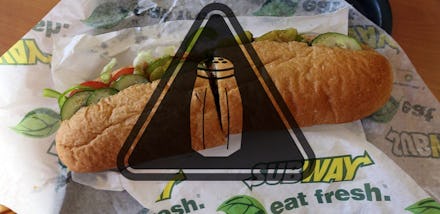New York Will Be the First US City to Put Salt Warnings on Restaurant Menus

Beginning tomorrow, New Yorkers might notice something different about their favorite fast-food joints: an ominous-looking black triangle next to certain menu items.
In an effort to fight heart disease — the cause of 1 in 4 deaths in America, according to the CDC — New York has become the first city in the nation to implement salt warning labels on chain restaurant menus.
Restaurants with at least 15 locations nationwide will be required to place the new labels next to any items containing at least 2,300 milligrams of salt.
Here's what the warning labels look like:
Why we should watch our salt: According to the American Heart Association, around 77.9 million Americans have high blood pressure, or hypertension — a condition that can contribute to health risks such as heart attack, stroke and, in some cases, death. Consuming too much salt can cause your blood pressure to rise.
"When you eat too much salt, which contains sodium, your body holds extra water to 'wash' the salt from your body," the Cleveland Clinic explains. "In some people, this may cause blood pressure to rise. The added water puts stress on your heart and blood vessels."
Unfortunately for Americans' health, too many individual menu items at popular restaurants contain more than 1,500 to 2,000 milligrams of sodium — the recommended daily salt intake for adults. Subway's footlong spicy Italian sub? A whopping 2,980 milligrams. Applebee's grilled shrimp n' spinach salad? Even more: 2,990 milligrams.
Dr. Howard Weintraub, clinical professor at the Leon H. Charney Division of Cardiology's Department of Medicine and co-director of NYU Langone's Center for the Prevention of Cardiovascular Disease, calls them "sodium bombs."
Weintraub, who regularly treats patients with high blood pressure, welcomes the new warning labels.
"Anything we can do that doesn't involve taking medicines, or that would allow us to limit the number of medicines, would be a great idea," he told Mic. "If it means what we do is ask for the cooperation of people in the restaurant sector, so be it."
Lots of people don't think about amount of salt they're consuming. Thanks to the successes of other lobbying groups, many of us monitor our fat and calorie consumption more closely than we do our sodium intake. "When [patients] come into my office and they talk about what their diet is, they're focused on fat content," Weintraub said. "They do not focus on sodium."
Weintraub is happy that salt is finally taking the stage. "It's an important step," he said.
But warning labels won't completely solve the problem. For one, the labels will only be placed next to items containing at least 2,300 milligrams of sodium. While they might make you think twice about ordering that Italian combo sandwich on ciabatta from Panera (2,810 milligrams), they still can't warn you against ordering multiple lower-sodium items that together add up to more than 2,300 milligrams.
And even if you start taking it easy on the salt, you're not automatically saved from hypertension and heart disease.
"The public would be best to be advised that reducing their salt intake is just the start of a good preventive program," Weintraub said. People should also watch their weight, limit their consumption of sweets, carbohydrates, saturated fats and trans fats, and get plenty of exercise.
"Each and every one of those interventions can lower blood pressure anywhere from three to seven or eight points — the equivalent of taking one or two drugs," he said.
Still, putting salt warnings on chain restaurant menus can only improve the public's journey toward improving its overall health.
"I think it's a question of chronic eating habits," Weintraub said. "By letting people see this as they go to different chain restaurants, this offers an opportunity for people to be able to know that there are some things that are bad."